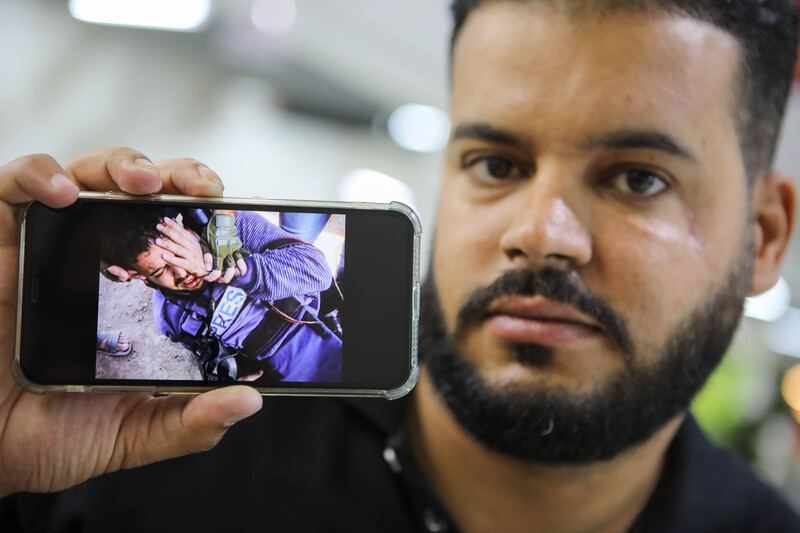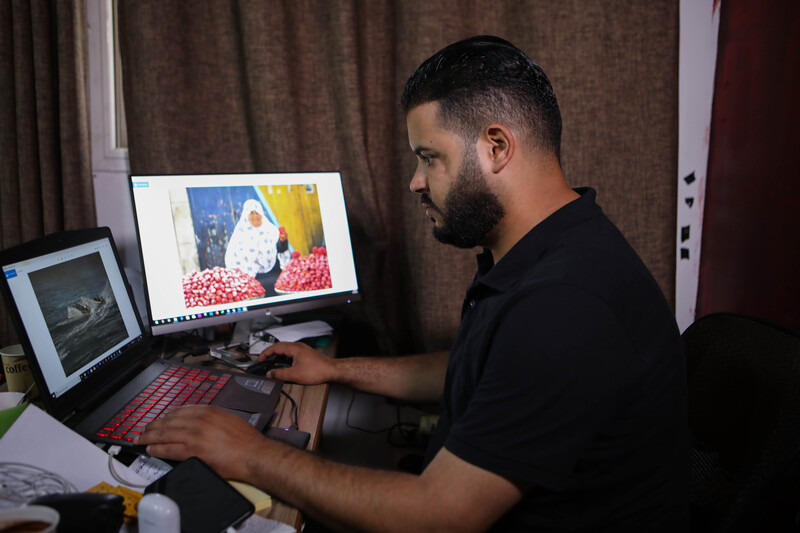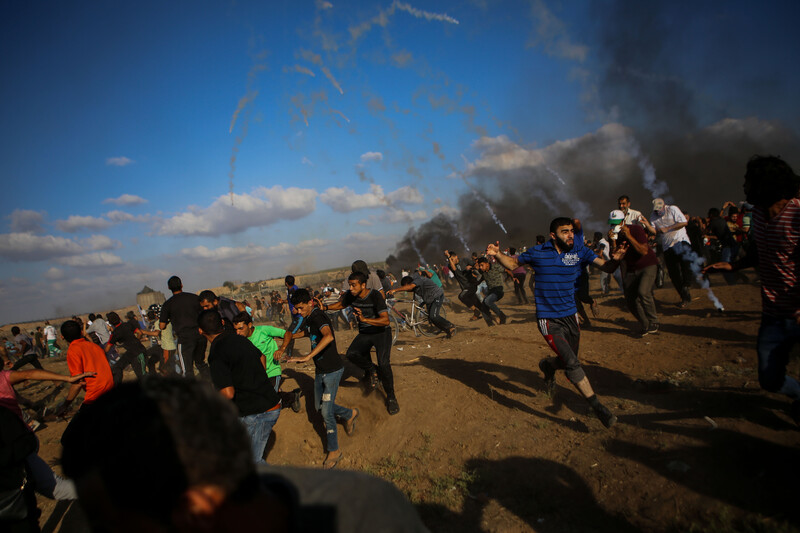The Electronic Intifada 6 November 2019

Atiah Darwish holds a cellphone with a photograph showing the moment he was injured by the Israeli military.
The Electronic IntifadaThrough his photography, Atia Darwish has documented how despite being under a brutal Israeli blockade, Gaza’s people still find moments of joy.
His image of Palestinian children eating watermelon by the sea was featured in an outdoor exhibition that toured Lebanon during September.
Many of those who marveled at the picture were probably not aware that the man who took it cannot work at the moment. Darwish has lost the ability to see properly – a vital requirement for a photographer – because of injuries inflicted on him by Israel.
On 14 December last year, Darwish was working at the Great March of Return protests in eastern Gaza. He had been taking photographs for approximately half an hour when he was wounded by a tear gas projectile.
Darwish lost consciousness. When he regained it, he found himself under intensive care in Gaza City’s al-Shifa hospital.
The projectile had hit him below his left eye. He lost some bones around it, as well as having his jaw damaged.
“My eye kept bleeding for a week and my ear for the next two days,” he said.
Darwish fears that his vision cannot be repaired.
In February this year, he traveled to Egypt for treatment. A doctor there diagnosed him with fibrosis of the retina and said that the condition was incurable.
“I can only have cosmetic surgery,” said Darwish. “I feel let down. The world doesn’t regard the bombs thrown at us by Israel as dangerous. But they can kill people and the dreams of our youth.”
Darwish cannot see beyond 15 centimeters with his left eye. He has also become partially deaf.
The dramatic change to his appearance caused by his injury has shocked Darwish.
“When I got back to Gaza [from Egypt], I felt hopeless when I looked at old photos of myself on Facebook and Instagram,” he said. “I will not be like that again.”

Atiah Darwish views some of his old photographs.
The Electronic IntifadaDarwish hopes to resume working as a photographer, relying on his right eye. “I will have to be more careful,” he said.
It was not the first time that Darwish had been hit by a tear gas projectile as he covered the Great March of Return.
In July last year, one such projectile hit his right leg. He had to be treated for burns afterward.
Non-lethal?
His injuries are far from rare. Although the Israeli military describes tear gas as “non-lethal,” the weapon has killed Palestinians.
At least seven people have died because they were struck by tear gas canisters fired by Israel during the Great March of Return protests that began on 30 March 2018. Four of those victims were children.
Hasan Nofal died after he was struck by a tear gas canister fired towards protesters in February. He was only 16.
His father, Nabil, is still struggling to understand what happened.
When he first heard that Hasan had been wounded, Nabil did not think the injury could be too serious. Hasan had kept a sufficient distance from the fence separating Gaza and Israel, Nabil had thought.
Hasan died four days after he was hospitalized.
“My son was innocent,” Nabil said. “Does the Israeli occupation know that the bombs it launches are killing people?”
With their plight often ignored by the Western media, protesters are wounded on a regular basis in Gaza. Al Mezan, a human rights organization, reported that 13 people taking part in the Great March of Return were directly hit with tear gas canisters on 25 October alone.

Israel’s tear gas weapons have killled and seriously injured protesters in Gaza.
The Electronic IntifadaAhmad Ammar, a 23-year-old from al-Shujaiyeh, a Gaza City neighborhood, was hit by one such projectile in September. His mouth and right cheek were badly burned, causing long-term damage to his face.
“I was away from the boundary fence,” Ammar said. “I was drinking juice because I was feeling dizzy from the tear gas, which has a strong smell. When I started to walk away slowly, I heard someone screaming at me to watch the tear gas bombs that were near me. I turned and suddenly was hit by one of them.”
Jobless
Ammar lost consciousness. “When I woke up, I was in hospital,” he said. “Some of my friends were next to me. I asked them for a mirror so that I could see my face. But they refused to give me one.”
Ammar used to sell vegetables at a local market. He has not gone back to work since his injury. He cannot think of anything apart from his injury and securing corrective treatment.
“I need plastic surgery,” he said. “Unfortunately, it cannot be done in Gaza. A number of doctors told me that we don’t have the resources here. And it is very expensive outside Gaza.”
“The tear gas which the Israeli occupation fires towards us kills our dreams and our hopes,” he said. “Every day I wake up and see how I look in the mirror. I feel terrible.”
Mohammad Fseifes has also become unemployed because of injuries he received at a protest in late May.
He used to work in construction and farming around the Khan Younis area of Gaza. He has been unable to take jobs since he was injured.
For about five months, he has had frequent headaches and found it difficult to sleep. He has not felt well enough to play football either.
Fseifes was near the boundary fence when Israeli troops hit him with a tear gas projectile.
“I remember that I fell to the ground,” he said. “Six days later, I woke up and saw my dad. I felt severe pain in my head. The doctor told me that my skull was fractured.”
“I feel very sad when I look at myself in the mirror,” he added. “The doctor says that I can have surgery to my skull. But it can only be done outside Gaza. I don’t know what is going to happen to me.”
Amjad Ayman Yaghi is a journalist based in Gaza.





